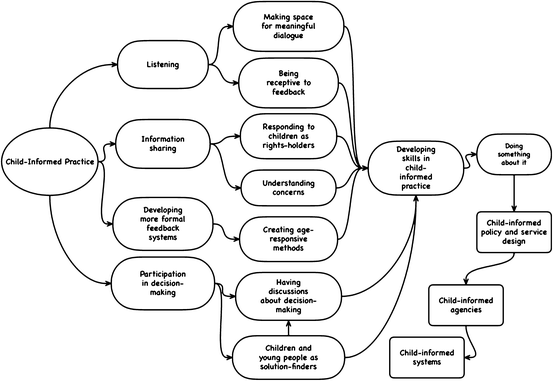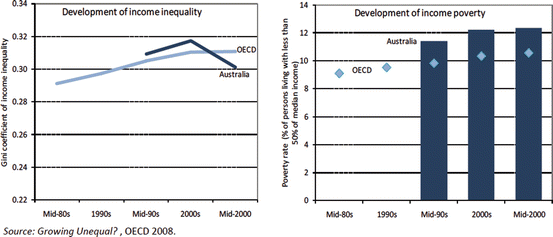Disadvantage, Equity and Children’s Rights in Twenty-First Century Australasia

Fig. 6.1
Income inequality started to decline in New Zealand around 2000 but poverty is still rising
Since 2000 Australia has also seen income inequality fall sharply (now below the OECD average, see Fig. 6.2), but there has been no reduction in poverty. In Australia one in six children live in poverty (Australian Council of Social Services (ACOSS) 2013), 17 % of Australia’s children. This means that children are at greater risk of poverty than the general population (13 %). In a recent statement UNICEF Australia noted “it is ironic that, while internationally the rate of child poverty is decreasing, a wealthy nation like Australia is slipping” (Peter 2013). Although it is difficult to calculate exact numbers, it has been estimated that child poverty affects between 500 and 600,000 children in Australia (ACOSS 2013) and between 170,000 and 270,000 in Aotearoa New Zealand (Children’s Commissioner 2012), depending upon the measures used. In any event, it is clear that children in both countries experience economic disadvantage and that effort to reduce this are having little effect.


Fig. 6.2
Income inequality has fallen in Australia but poverty has risen, especially since 2000
6.3 The Impact of Inequality
Both Australia and Aotearoa New Zealand pride themselves on being great countries to raise children. According to Gould (2013, p. 236) “… social justice and a fair distribution of income and wealth have always been, until recently, the hallmarks of a well-functioning society and a fully effective democracy”. Yet child economic inequality continues to create inequity, disadvantage and hardship for many children and their families. Among OECD countries Aotearoa New Zealand has the second highest proportion of children (aged 5–14 years) living in jobless families, and Australia has the fourth highest (Fig. 6.3). Living in jobless households not only creates increased chances of economic deprivation, it also has the potential to frame expectations and influence work attitudes and opportunities.


Fig. 6.3
Among OECD countries, Aotearoa New Zealand has the second highest proportion of children (5–14 years) living in jobless families, Australia has the four highest (Adapted from Moore and McDonald 2013, p. 9)
Poverty is, of course, relative. People experience poverty in developing countries differently than those in high income countries. It is nevertheless clear that children in Australia and Aotearoa New Zealand experience poverty in ways that impact negatively on their well-being and future life chances. Writers have suggested that child poverty can impact on children’s health and wellbeing in three distinct ways (Children’s Commissioner 2012). Firstly it can impact on a parent’s ability to provide basic resources such as food, and other opportunities that would enhance the child’s development, the ability to access quality child care, educational resources and so on. Secondly it can create adverse parenting conditions – the stresses created by persistent poverty impact negatively on the parent’s wellbeing causing negative consequences for the child. Third, poverty can influence physiological and neurological development causing long-lasting negative effects on the child’s health and functioning. Experience of sustained poverty is also associated with longer term disadvantage:
It is now well established that poverty can impact on health, educational achievement, the ability to live in secure housing, the ability to form friendships, as well as creating feelings of shame and a lack of hope with respect to future life chances (Children’s Commissioner 2012). Some children are also more affected by poverty than others. Aboriginal and Torres Strait Island peoples are affected disproportionately, and poverty has been identified as a core explanation for ill health in Australia’s First People (Walter 2007). Overall, Aboriginal households are poorer than non-Aboriginal households, having incomes at least 40 % below the national median. According to Walter (2007, p. 79):
poor children tend to begin school well behind their more affluent peers, and lose ground during the school years. Children from poor families also go on to complete less schooling, work less and earn less than others. (Moore and McDonald 2003, p. 13)
On broader measures of socio-economic inequality, Aboriginal people are: more than fifteen times as likely to be imprisoned as adults; seventeen times as likely to be detained as juveniles; and have comparative rates of homelessness more than three times those of non-Indigenous Australians.
Similarly, rates of poverty differ across ethnic groups in Aotearoa New Zealand. Although half of all children experiencing poverty are of Pakeha/European background, Maori and Pacific Peoples experience disproportionate levels of poverty – double that of Pakeha children and twice as likely to experience severe poverty. For many Indigenous people in Australia and Aotearoa New Zealand the burden of disadvantage is inextricably linked to experiences of colonization (Ruwhiu 2013; Gilbert 2013). It is important therefore to understand the place of Indigenous peoples in colonized countries and the ongoing struggle against disadvantage and in securing human rights.
6.4 Participation, Advocacy and Democratizing Children’s Rights
UNICEF’s multidimensional definition of poverty, discussed earlier in this chapter, inextricably links poverty, disadvantage and experiences of exclusion with notions of children’s rights. Within UNCRC’s articulation of children’s rights, three areas have been specifically identified for action:
Provision – having their basic needs met
Protection – being protected from abuse, neglect and exploitation
Participation – playing an active role and a say in what happens to them.
In some respects, whilst material inequality and child abuse continue to challenge all Western countries, the first two areas might seem easier to come to grips with than the last. Yet without a purposeful commitment to facilitating children’s participation, professionals will struggle to understand the unique circumstances of children facing poverty and disadvantage. Understanding the deep concerns that children may have about their position in the world, for example their feelings of inclusion or exclusion, requires practices that are not constrained by adult/child hierarchies. Practice needs to provide contexts in which children are listened to, where access to information is child-friendly, and where there is transparency of decision-making of which the child is an important participant. Engaging with the child’s world increases professional focus toward the strengthening of equality and inclusion, and actively addressing issues of discrimination.
Although notions of children’s rights and participation have now been articulated for the past several decades, the degree to which children’s views and perspectives influence policies and practices that concern them is debatable. Children involved with systems of child welfare are among the most marginalized and disadvantaged children in society. Recognizing this, UNCRC clearly expects that these children will be actively involved in matters relating to their care and wellbeing:
Research relating to the perspectives of children nevertheless reveals a number of challenges in fostering this active participation:
State Parties shall assure to the child who is capable of forming his or her own views the right to express those views freely in all matters affecting the child, the views of the child being given due weight in accordance with the age and maturity of the child. (Article 12)
A growing body of research indicates that systems of child welfare could do much more to incorporate a children’s rights perspective in their service responses. What is sometimes difficult to conceptualize, however, is what more responsive systems might look like. (Connolly and Ward 2008, p. 139)
Although children and young people are direct stakeholders in service provision, there remains what Galanos (2014, p. 11) refers to as a “gap between participation rhetoric and practice”. Galanos’s scoping review of research that engages with children and young people directly illuminates shortfalls in the skill base of social workers and other professionals in terms of fostering strong relationships with children and young people, including the amount of time professionals dedicate to relationship building. It is nevertheless through deep engagement that professionals can understand the expressed concerns of children and the ways in which facing poverty, disadvantage and exclusion impacts on their lives.
Creating more child-informed practices in child and family welfare is complex as so many areas of children’s agency are dependent upon the authority of adults (Redmond 2008). Professionals control most aspects of child and family welfare practice and generally discretion over the sharing of information, processes of communication and decision-making rest with professionals. Child protection services tend to be adult-focused, decisions being made by adults in the best interests of children. Interpreting children’s best interests through an adult lens, however, is likely to miss children’s unique perceptions, and the ways in which they may be engaged in solutions. It is clear that children want to be consulted, provided with information and have their opinions heard in meaningful ways (Morrow 2004). The challenge is to develop child-informed practices that are respectful, meaningful, and practically possible – from the most basic level of power sharing to more sophisticated levels – across the spectrum of practice.